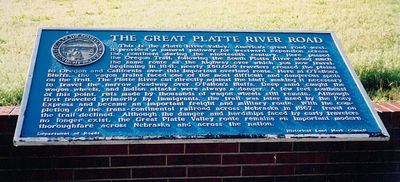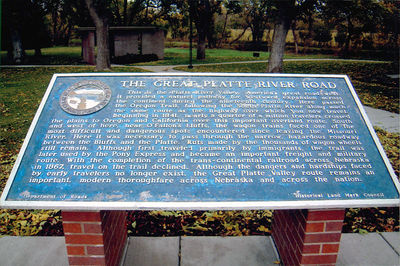Difference between revisions of "Nebraska Historical Marker: The Great Platte River Road (1 & 2)"
| Line 1: | Line 1: | ||
| − | [[Image:NHM_110_1_11.jpg|thumb|center|upright= | + | [[Image:NHM_110_1_11.jpg|thumb|center|upright=2.0|alt=NHM_110_1_11.jpg| Nebraska Historical Marker 110 at rest area near mile marker 159 on I-80 Eastbound]] |
| − | + | [[Image:NHM_111_1_1.jpg|thumb|center|upright=2.0|alt=NHM_111_1_1.jpg| Nebraska Historical Marker 111 at rest area near mile marker 159 on I-80 Westbound]] | |
==Location== | ==Location== | ||
Historical marker 110: Rest area near mile marker 159, I-80 Eastbound, Sutherland, Lincoln County, Nebraska | Historical marker 110: Rest area near mile marker 159, I-80 Eastbound, Sutherland, Lincoln County, Nebraska | ||
Revision as of 09:53, 24 February 2017
Location
Historical marker 110: Rest area near mile marker 159, I-80 Eastbound, Sutherland, Lincoln County, Nebraska
View this marker's location 41.138576, -101.0958
Historical marker 111: Rest area near mile marker 159, I-80 Westbound, Sutherland, Lincoln County, Nebraska
View this marker's location 41.141636, -101.0899
View a map of all Nebraska historical markers, Browse Historical Marker Map
Marker Text
This is the Platte River Valley, America's great road west. It provided a natural pathway for westward expansion across the continent during the nineteenth century. Here passed the Oregon Trail, following the South Platte River along much the same route as the highway over which you now travel. Beginning in 1841, nearly 250,000 travelers crossed the plains to Oregon and California over this important overland route. Here at O'Fallon's Bluffs, the wagon trains faced one of the most difficult and dangerous spots on the trail. The Platte River cut directly against the bluff, making it necessary to travel the narrow roadway over O'Fallon's Bluffs. Deep sand caught the wagon wheels, and Indian attacks were always a danger. A few feet southeast of this point, ruts made by thousands of wagon wheels still remain. Although first traveled primarily by immigrants, the trail was later used by the Pony Express and became an important freight and military route. With the completion of the trans-continental railroad across Nebraska in 1867, travel on the trail declined. Although the dangers and hardships faced by early travelers no longer exist, the Great Platte Valley route remains an important modern thoroughfare across Nebraska and across the nation.
Further Information
Bibliography
Marker program
See the Nebraska Historical Marker Program for more information.

